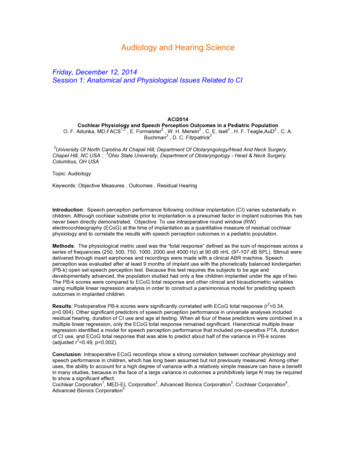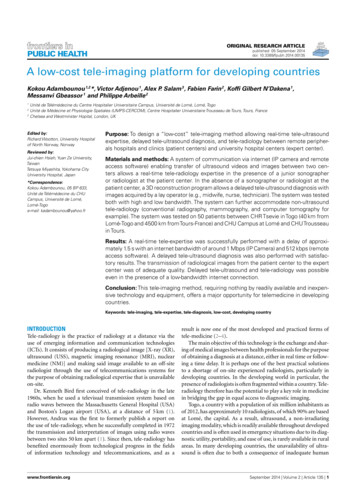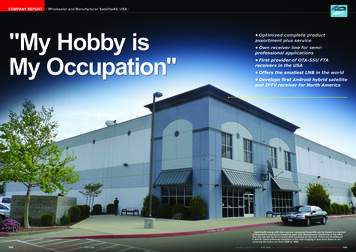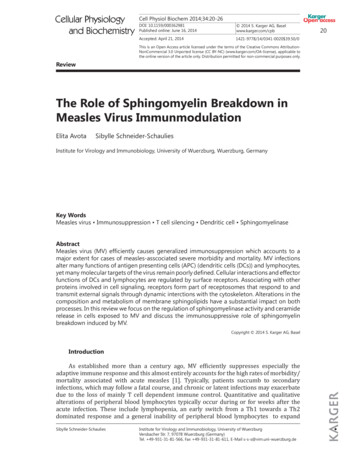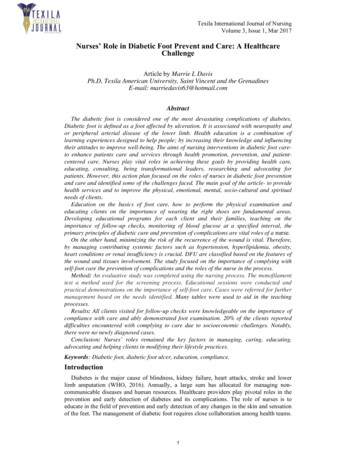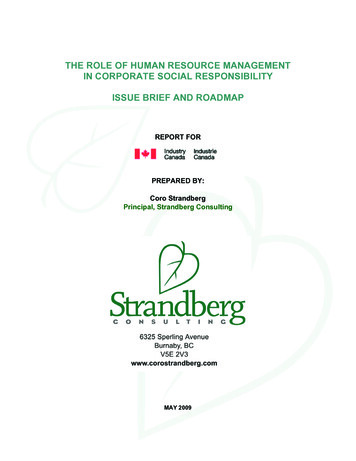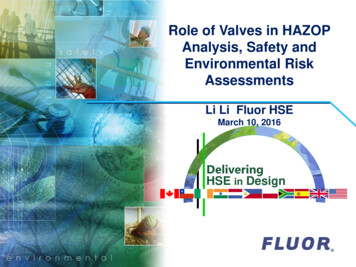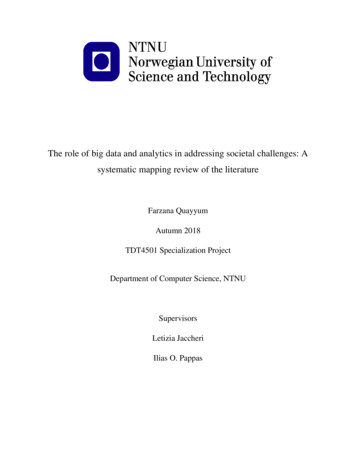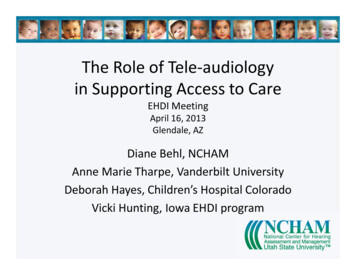
Transcription
The Role of Tele-audiologyin Supporting Access to CareEHDI MeetingApril 16, 2013Glendale, AZDiane Behl, NCHAMAnne Marie Tharpe, Vanderbilt UniversityDeborah Hayes, Children’s Hospital ColoradoVicki Hunting, Iowa EHDI program
Role of Tele-audiology in EHDI Increased access to diagnostic evaluations reducing loss to follow up Include interpreters and cultural brokers Support culturally competent services Provide remote hearing aid management, CIprocedures timely intervention
Learning Community Purpose:Share, Expand, CreateOrganizational/politicalprocessesTechnology nuts & boltsInterpersonalprocedures
Learning Community Members CaliforniaCanadaColoradoIowaTennesseeWisconsinUtah
Key Factors Building partnerships, laying groundwork Ensuring secure, high-quality servicedelivery Family-centered services Reimbursement Resources
Tele-Audiology in GuamImproving Access to Care from 7,000 MilesAway!Deborah Hayes, Ph.D.University of Colorado School of MedicineChildren’s Hospital ColoradoNational EHDI ConferenceApril 16, 2013
HAFA ADAI!GUAM: A FEW FACTS U.S. Territory acquired in 1898 followingthe Spanish-American War Native people are Chamorro from AsianPacific region Japanese occupation during World War II;re-captured by the U.S. in 1944 U.S. military presence with Naval and AirForce Bases Semi-tropical island about 30 miles x 8miles in size Civilian population of 170,000 Birthrate for 3,300 infants/year“Fiber Optic Flower” on aBeachfront Tree
Purpose of this Presentation Describe why tele-audiology for infant diagnostic audiological evaluations(DAE) was considered for the Guam EHDI program Enumerate steps in the process of launching a tele-audiology practice ininfant DAEs Identify issues specific to the practice of tele-audiology Discuss personnel, hardware, and software requirements for our project Describe test results to date Summarize challenges and solutions in tele-audiology practice
Loss to Follow-up at DAE in GuamSlide courtesy of Elaine Eclavea, M.Ed., University of Guam
Issues in Completing Infant DAEsLack of Audiologist comfortable in testing newbornsRepeated AABR screensEquipmentParent refusalProcess taking too longParents seeking testing off-islandLack of enrollment into early intervention programs
Possible SolutionsFind an audiologist on island or within the PacificregionNo university training program in GuamOn-island audiologists fully committed with jobresponsibilities, unavailable to civilian population, ornot well-experienced in infant DAEs“Transient” audiologist who could fly to Guamseveral times/year for testingOption of tele-audiology
Tele-audiology for Infant DAEProviding infant DAEs over the internet emerged from apresentation and subsequent discussion with EHDI coordinatorsfrom the Pacific Rim including Guam, Palau, Federated States ofMicronesia, Saipan, and Commonwealth of Northern MarianaIslands at EHDI Meeting (2010)Guam was selected as the pilot site becauseSufficient birthrate to ensure enough babies to test the conceptAvailability of organized screening and early intervention programsAdequacy of internet and travel services to facilitatecommunication and interaction
Steps in the ProjectDeveloping of a Memorandum of Understanding outlining each party’sresponsibilitiesVisiting site of tele-audiology in Guam by Children’s Hospital Colorado staffEvaluate test environment and equipmentTrain Guam-based technicians (DOE audiometrists)Develop procedures jointlyAcquiring Guam audiology licensureIdentifying HIPAA-compliant software for remote control of Guam diagnosticaudiometric equipment and videoconferencingTesting/retesting software solutionsEnsuring a successful first tele-audiology testScheduling a Children’s Colorado audiologist on Guam for “Go Live”
Issues in Tele-audiology PracticeProfessional licensingChildren’s Colorado audiologists obtained a Guam audiology license priorto testingPrivacy and confidentialityRemote control software is approved as secure for testing over theinternet by Children’s Colorado; no infant identifying information istransmitted during testingVideoconferencing software encrypts audio and video transmissionLiability and malpracticeChildren’s Colorado audiologists are covered by the hospital’s liabilityinsurance policyInformed consent is obtained from parents prior to testing
Personnel for Tele-audiologyIn ColoradoTwo licensed (Colorado and Guam) audiologists from Children’sHospital ColoradoProject leadershipTechnical supportIn GuamTrained technicians (Guam DOE-Part B audiometrists)Project leadership from Guam EHDITechnical supportGuam Family Supporters from Guam Early Intervention Services(GEIS)
Technology for Tele-audiologyIn Guam:Bio-logic Navigator PRO (NavPRO) for auditory brainstemresponse, otoacoustic emissions, auditory steady stateresponseGSI TympStar and Interacoustics Titan for tympanometryand middle ear muscle reflexesLaptop for videoconferencingIn Colorado:Desktop PC for remote control operation of NavPROLaptop for videoconferencing
Software for Tele-audiologyNetop Remote Control software for audiologist in Coloradoto “take control” of Guam NavPROColorado is “guest” and logs into Guam NavPRO through public IPaddressGuam is “host” and allows Colorado to take control of NavPRONo infant identifying information is transmitted during testingNefsis videoconferencing softwareGuam holds Nefsis videoconferencing licenseColorado connects to videoconference established by Guam viasecure website
First “Go Live” in GuamA mother holds her infant duringteleaudiology testing to determinewhether or not her infant has a hearingloss. Technology enabled Dr. ErickaSchicke at Children's Hospital-Coloradoto operate the diagnostic audiologicalequipment remotely from Colorado, afterBobbie Maguadog (left), Department ofEducation audiometrist, and Dr. SusanDreith (center), audiologist, Children'sHospital-Colorado, prepared the parentand infant for testing on Guam. (Photocredit: University of Guam)
Tele-audiology Results to DateXX test sessions completed to date (March 21, 2013)XX infants received complete diagnostic assessment; Xinfant received partial ABRbut did not sleep for remaining tests Otoscopy (by Guam audiometrist)TympanometryOtoacoustic emissionsAuditory brainstem response (air and bone conduction as needed)Auditory steady state response (air and bone conduction as needed)Diagnosis and recommendations provided to family by testing audiologistFormal report generated by testing audiologist for family and primary medicalproviderAudiological diagnosis facilitated referral for medical services for XX infantsXX additional infants scheduled for April 2013
Challenges in Tele-audiologyIdentifying an appropriate test environmentIdentifying and training support personnelScheduling appointments across time zones (16 hourdifference between Colorado and Guam)Interruption of internet services during testingMeasuring effectiveness of family counseling delivered byvideoconferencingIntegrating infant DAE services into full EHDI program toattain quality outcomesSustaining services beyond pilot phase
What We have LearnedInfant diagnostic audiological evaluations can be effectivelyprovided over the internetSite visit(s) is/are critical to success of tele-audiologySoftware solutions must meet contemporary standards forinfant and family privacy and confidentialityTele-audiology is optimally delivered within the context ofcomprehensive services for the infant or patient and familyTele-audiology can be a successful approach for providingservices in rural and remote communities
Tele-Audiology in IowaVicki HuntingProject Director, Improvement AdvisorChild Health Specialty Clinics (CHSC)Partnership to Improve Child Health in Iowa (PI CHI)Early Hearing Detection & Intervention (EHDI)Assuring a System of Care for Iowa’s Children and Youth with Special Health Care Needs
Iowa DemographicsAssuring a System of Care for Iowa’s Children and Youth with Special Health Care Needs
Iowa EHDI HRSA Grant – University of Iowa, Department of Pediatrics,Child Health Specialty Clinics (CHSC)– Hands & Voices, Guide By Your Side (GBYS) for Family Support– Technical Assistance from Audiologists @ Center for Disabilities& Development (CDD), Iowa’s University Center for Excellence inDevelopmental Disabilities (UCEDD)– Long Term Follow-up CDC Grant – Iowa Department of Public Health (IDPH)– Surveillance/Data– Relationship with birthing centers– Short Term Follow-upAssuring a System of Care for Iowa’s Children and Youth with Special Health Care Needs
Set-up “Hub “in Iowa City @CDD with Audiologists “Spoke” in Oelwein @CHSC Regional Center(RC) with RNAssuring a System of Care for Iowa’s Children and Youth with Special Health Care Needs
Equipment Vivosonic Integrity @ Spoke site (Oelwein)GoToAssist – Spoke & Hub (Iowa City/Oelwein)Polycom – Spoke & Hub (Iowa City/Oelwein)Hi Def flat screen monitorAssuring a System of Care for Iowa’s Children and Youth with Special Health Care Needs
Iowa Process1. Child does not pass 2nd screen (OP)2. Proximity to CHSC Oelwein RC3. Appointment is scheduled4. Appointment attended5. Test is complete6. Results shared - on the spot7. Next Steps/Referrals8. Community Resources and additional services shared.9. Results documented in state database & UIHC EMR10. Follow-upAssuring a System of Care for Iowa’s Children and Youth with Special Health Care Needs
Audiological ServicesPrior to the Appointment: Audiologist/RN meet discuss appt Configuration test, setup connections, ensure workingorderDuring the Appointment: RN may repeat OAE screen if warranted RN Puts on electrodes Otoscopy @ Spoke Click thresholds Tone bursts thresholds Future: Include capacity for high frequency tympAssuring a System of Care for Iowa’s Children and Youth with Special Health Care Needs
Community Services Oelwein RegionalCenter also employsSocial Workers, FamilyNavigators, on site Access to Hands &Voices Guide By YourSide (GBYS) Parent anddeaf/hard of hearingGuidesAssuring a System of Care for Iowa’s Children and Youth with Special Health Care Needs
What’s Important to Families Communication Communication Communication!!!!Knowing what to expect from thisTele-Audiology experienceCommunication during testing aboutwhat’s happeningCommunicating with otherprofessionals, their families aboutresultsServing and understanding diverseculturesRecords, results andcounseling/family supportWhat happens nextCommunity supports and servicesavailable to themOut-of-pocket costs/InsuranceAssuring a System of Care for Iowa’s Children and Youth with Special Health Care Needs
ReimbursementToday Grant activity Everything is within University of Iowa Hospitals and Clinics (UIHC),Department of Pediatrics Family pays nothing (okay for now, low referrals) RN @ spoke site– nursing licensure board says this is within RN “scope of practice”Future Challenge, reimbursement for tele-health in Iowa Arranging reimbursement from third party payers;– Medicaid, private insurersAssuring a System of Care for Iowa’s Children and Youth with Special Health Care Needs
Challenges MarketingReferralsStable Bluetooth connectionsThird Party ReimbursementSustainabilityAssuring a System of Care for Iowa’s Children and Youth with Special Health Care Needs
Contact InformationVicki Hunting515-331-0750Vicki-hunting@uiowa.eduAssuring a System of Care for Iowa’s Children and Youth with Special Health Care Needs
Teleaudiology: The VanderbiltPerspectiveAnne Marie TharpeDevin McCaslinRene GiffordGina AngleyVanderbilt Bill Wilkerson CenterVanderbilt University School of Medicine
Steps to Take:1.2.3.4.5.6.Identify area(s) of needFind project partnersSet goalsOperationalize processDetermine technical/equipment needsAssess/re-assess
Examples from Vanderbilt
Project I: Remote NewbornHearing Screening
Identify Areas of NeedMadisonCoShelbyCoHamilton Co
BuildingI think you’vewaited too latePartnershipsto find me!
Find Project Partners Maternal Child Health Bureau(LEND) TN Department of Health LeBonheur Children’s Hospital(Memphis) W. Tennessee School for the Deaf Methodist Hospital (Memphis) U Tennessee (Knoxville) East TN State U (Johnson City)
Set Goals Decrease family drive time ( 2.0 hours) Develop protocols Develop educational materials (familiesand physicians) Pilot in most needy area(s) first Reduction in loss to follow up(long term)
Remote AssessmentRemoteelectrodesearphonesHost
Training of Support Staff Exporting expertise in electro-diagnostics torural areas– Screenings in the NICU: 850 / year– Repeat screenings in clinic: 350 / year– Diagnostic ABRs: 250 / year
Procedures and Protocols Includes:–––––––Establishing the link between the Host and remote siteIntroduction of everyone presentDiscussion of procedures with caregiverSkin preparation of infantElectrode and earphone placementElectro-diagnostic evaluationCounseling
Project II. Remote CI Programmingand Intraoperative Monitoring
Identify Need: Dozens of CI programs in the U.S. Handful of centers implanting 100 implants/year Even fewer centers implanting 150 implants/year Largest, most experienced centers in largemetropolitan areas Few options for patients with complicatedmapping and management needs
Remote Intraoperative Monitoring of Device Integrity &eCAP Thresholds During CI Surgery Device integrity checks and intraoperative completion of eCAPthreshold estimation Requires “in person” equipment setup, initial device check,and verification of data connection Completed on the VUMC campus “within the firewall” Communicate with surgical team via phone during testing
Remote Intraoperative Monitoring of Device Integrity &eCAP Thresholds During CI SurgeryRequired items: Secure data connection Two computers Remote control software DameWare (VBWC) Others: LogMeIn, Windows RDC, TightVNC, UltraVNC, ScreenConnect,Team Viewer, Bomgar, etc.Non-required items (unique for this application): Remote IT assistant Video connection
Tested approximately 200 patients remotely to date Increased efficiency OR presence 2-3 hours Remote presence 26-39 minutes (depending on OR location) Increased clinician productivity Audiologist is seeing clinic patients during surgery Gets called out for total of 3 minutes to remotely test Downside surgeons prefer a physical presence Student training in the OR might be compromised
Project III: Distance Support forHearing Aid Users
Set Goals:To evaluate hearing aid software that wouldallow a clinician to provide follow-up care(i.e. adjustments, counseling, reinstructionon hearing aid maintenance, etc.) remotely
Distance Support Study Patient Demographics– 22 Females; 31 Males– Age Range: 32-80 years– Average Mileage: 32.80 miles– Average Time to Clinic: 37.93 minutes
Distance Support Study Phase 1 Procedure:– wirelessly connect to Vanderbilt’s internet– instruction manual provided to patients– patient installs software onto a clinic computerand sets up the necessary hearing aidprogramming device without assistance or withminimal assistance from the clinician– clinician goes to another room (down the hall),calls patient and talks with them whileadjustments are made to the hearing aids
Distance Support Study–Satisfaction surveys Patient Clinician
Distance Support Study Results:– 50 patients completed– Stable connectivity to patients On a few occasions connectivity was lost usually due toinsufficient battery current– Patients were able to install the software in 5-10minutes– Patients felt installation process was relativelystraight forward (only 2 unable to install)
Distance Support Study Survey Results:– No clear profile of who was an appropriatedistance support candidate Majority of patients could install the softwareregardless of age– Patients often indicated preference for remotecare even if geographically close to clinic
Challenges
Remaining Challenges Which model to adopt? Infrastructure and security What is the funds flow?– Who gets reimbursed?– Who invests in equipment? Re-engineering clinics to suit the model Patient acceptance/Clinician acceptance Student training
Thank you!Maternal Child Health BureauLEND Training ProgramVanderbilt Telehealth TeamAll of our partners
A Word About HIPAA Privacy and Security Same privacy rules in face-to-face apply to T-A Consider who else is present on the provider end and theclient end Security applies to electronic transfer of information,primarily recordings– Encryption, limited provider access Risk Analysis– Cohn, Ellen (2011) Privacy and Internet-based Telepractice,Perspectives on Telepractice. Sept., v.1, no.1 p. 26-37
Reimbursement & Licensing(National Telehealth Policy Resource Center, a program of the Center forConnected Health Policy; Feb. 2013) 44 states have some form of reimbursement for telehealth intheir public program– Those that do not : CT, DC, IA, MA, NH, NJ, RI Proposed The Telehealth Promotion Act of 2012 (H.R. 6719)would require reimbursement of telehealth for any servicecovered face-to-face
Licensing To date, providers must be licensed in the statewhere the client is located DOD/VA providers need only be licensed in theirhome state to treat the military and veterans locatedanywhere Proposed The Telehealth Promotion Act of 2012(H.R. 6719): Provider needs state license only in statewhere living, practice anywhere else
Essential Resources ASHA SIG 18: Telepractice American Telemedicine Association– Submitted request to create Standards and Guidelines NCHAM (infanthearing.org)– Tele-intervention Resource Guide– Telehealth– Tele-audiology coming soon
Questions? Comments?Thank you!
Remote control software is approved as secure for testing over the . Desktop PC for remote control operation of NavPRO Laptop for videoconferencing. Software for Tele-audiology . Results documented in stat
